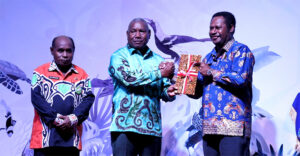
Who would have thought if the koteka which were identical as the traditional clothes of several tribes in Papua were actually made from water pumpkin plants (Lagenaria siceraria (Molina) Standl)?
Some people think koteka is made of wood or animal horns, because it has a hard material texture. Though koteka is made from water pumpkins which are the oldest cultivated plants.
Reported on the page historia.id, koteka derived from the language of the tribe ‘Mee’, a tribe who lives in the western part of the Central Mountains, Papua, including the districts of Paniai, Dogiyai, Deiyai, Intan Jaya, and Nabire. In Mee, Ekagi, and Ekari, koteka means clothes.
Koteka is often seen used by men from the Dani tribe (one of the indigenous tribes in Papua) as a cover of the genitals. Besides functioning as a cover of genitals, Koteka also functions as a marker of social status, pride and even a symbol of resistance.
Moving on to pumpkin plants, these plants are known to easily adapt to weather conditions, both in the rainy or dry season. For the Dani people (the largest tribe who inhabit Baliem, Papua), water pumpkins are usually planted in the yard. Pumpkin is not only planted as food but also used as a household tool.
Pumpkin water spreads, creepers, has a strong stem, notched looks and tendrils usually spiral. The leaves have 5-30 cm long stems, 10-30 cm wide, oval-shaped leaf strands with a base like a heart. Jagged leaf edges and lower surface with fine white hair. Is a female flower, pumpkin has short-stemmed flowers and strong textured.
Water pumpkin itself belongs to the hard-textured variety of pumpkin. The fruit varies, ranging from rounded to elongated elongated (10-10 cm in length). Young water pumpkin fruit is usually used as a vegetable. As for the old fruit, in addition to making koteka, can be made into a container of water, tubes or decorative bags. Each plant can produce 10-15 fruits or more.
Water pumpkin plants contain many health benefits. Quoted from the Journal of Chemical Sciences (2017), water pumpkin leaves and fruit contain saponins and polyphenols. Decoction or pumpkin juice can be used as an anti-emetic and headache medicine, but it can also overcome baldness.
From the writings on the page historia.id, in making koteka, calculated since the planting of pumpkin. After a few months the pumpkin ready for harvest is picked and then dried in the fireplace. The drying process is around 1 to 2 weeks. Usually the process is made for more than one koteka.
After the pumpkin is dry, then the contents of the pumpkin are removed until the remaining pumpkin skin is hard. Pumpkin that has been cleaned again is dried in the fireplace, and after that it is ready to be paired. Once installed, the koteka is one with the owner and will not be replaced until it is damaged. So as not to fall when worn, koteka tied a fine rope around the waist.
Pumpkin formation also has its own meaning and purpose. For the indigenous / Dani community, the shape of the koteka signifies the social class of the wearer. Curvy Koteka is only worn by people who have influence in society.
Quoted from historia.id, for koteka whose ends are curved forward (kolo) carried by Ap Kain or confederation leader (clan leader). Whereas the middle class wears koteka whose edges are curved to the side (haliag). These middle class include Ap Menteg (warlord) and Ap Ubalik (physician and traditional leader). For the shape of the perpendicular koteka may be used ordinary people.
In order to get a straight koteka shape the pumpkin is bound with stones. If you want to get a curved koteka, then before harvesting the stone tied to the hanging is released
To add a dashing impression and add attraction to the opposite sex, the tip of the koteka is usually mounted with a crest made of chicken or bird feathers. For children who are five years old are also starting to be allowed to use koteka. In addition to being a means of covering the genitals and a symbol of pride, the city is also one of the souvenirs that can be purchased when visiting Papua.







